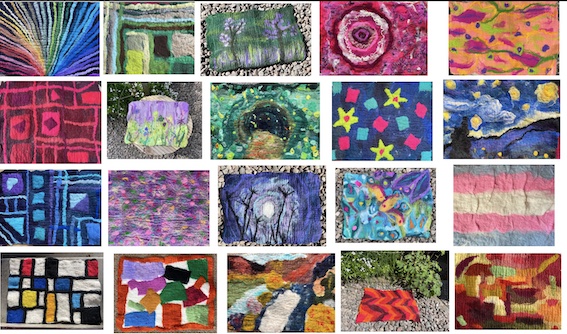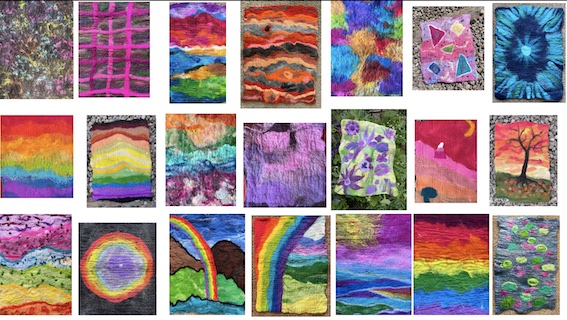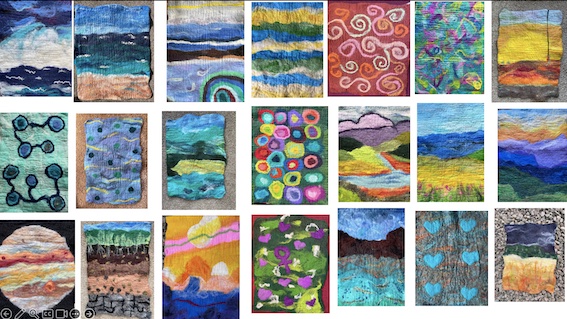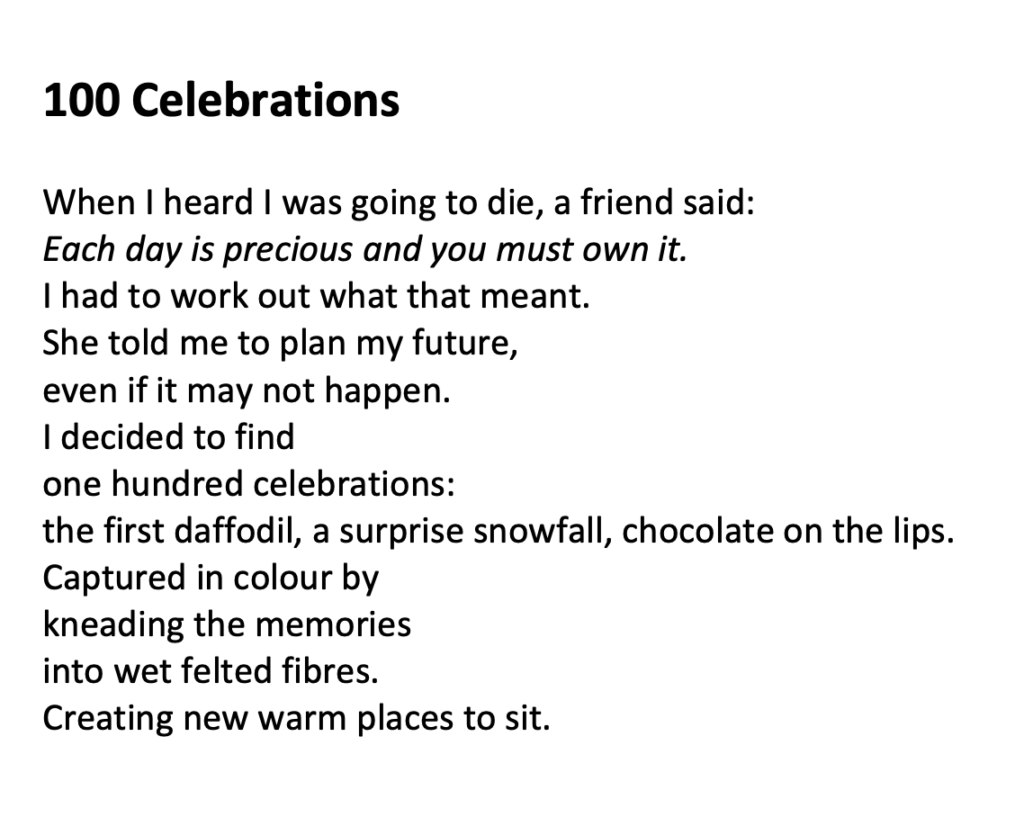
Since visiting Sweden in 2008 as part of my Churchill Fellowship, I have been inspired by the felted seats I saw at Mulleborg I Ur och Skur (In Rain of Shine) Outdoor Nursery. I came home and in due course acquired some merino wool to make my first felted seat. To my amazement it worked. It wasn’t particularly interesting but I was just pleased to have made one. Off and on I continued experimenting with ways of making this doable with young children. I also tried using native British breeds of gathered and donated wool with mixed success.
Last summer, I was left with a lot of merino wool leftover from running outdoor art courses. I decided to put this to good use by making wet felted wall hangings for my family. These were well received. Then I offered to make a wall hanging for my transgender niece. She wanted the transgender flag. It didn’t fit as a wall hanging but I remember it would be ideal as a felted seat. That was the beginning of my 100 Felted Seat Project.

I got the idea from reading Suleika Jaouad’s inspirational book, Between Two Kingdoms. She was diagnosed with Acute Myeloid Leukaemia, aged 22. After going through her stem cell transplant, Suleika decided to commit to writing a journal entry each day for 100 days. Reaching Day 100 is a very big deal when undergoing a stem cell transplant. So it was a very neat idea. Her family joined in, all with doing different creative commitments for 100 days.
At the time, I had no idea whether I would make it to Day 100. The uncertainty of my life is such that at any given moment I can develop an infection that lands me in hospital and I may or may not survive. I have almost no immune system and rely on prophylactic drugs to keep me alive alongside regular blood transfusions. My bone marrow only manages to produce a tiny percentage of healthy blood cells. The rest are cancerous and useless at doing the job of mature, fully-functioning blood cells.

Felt seats have provided a home for creative explorations for me. There have been several reasons why this has worked:
- They take very little time to make. Usually between 1 and 3 hours depending on the complexity of the design. I don’t worry about perfect designs and finish. My nephew who is 11 years old easily managed to make one for himself too.
- I’ve self-taught myself. I’ve not needed to attend a felting workshop. I’m extremely grateful to all the professional and accomplished amateur textile artists and felters on Instagram who have shared their work and techniques. Their inspiration has been great. Many have videos and downloadable booklets which have helped. I’m also very grateful to my friends on Instagram who have kindly looked at what I’m up to and given me encouragement.
- It has been an absorbing way of learning new skills. My seats are full of experiments, some which have worked and some less so. It is great fun to try new ideas such as using nepps (tiny balls of wool) or cut up old socks, peel off tiny threads of old sari silk, try different types of wool and so on.
- I’ve loved searching online for artists whose work can be translated into felt. Wet felting is a rough process and so the results are never accurate and there’s always a bit of flexible interpretation needed. I can’t needle felt owing to the risks of being jabbed with a needle (and infection setting in).
- The physical act of creating them has been “physio-felting”. My gammy shoulder is 90% better. The gentle motions and light lifting have worked wonders. Whilst I still have nerve damage from my neck, the relief of a pain-free shoulder is remarkable.
- They are a gift from me to family, friends and sometimes the occasional stranger. I still have a lot of family who need seats, so I’ll go beyond 100. When they wear out, the seats can be composted and the materials recycled back into the earth which is a natural process. Interestingly, a friend who now lives in Norway told me that many family create felt seats by cutting out a large square from the front and back of a wool jumper and rubbing these together until they felt – I’ll have to try this out in due course!
- They contain a part of me. The seats will go with people to places I have loved. Part of me will go back to these places and some of me will go to new places. I’ll keep travelling and exploring through my friends and family using the seats. Some friends and family have decided to turn them into wall hangings. I don’t mind. It’s their seat to use as they see fit.

Finally what I hope, is that the concept of using felted seats outside as an alternative to oil-based products grows as a concept. That in future outdoor learning and play conferences someone will offer felt seat workshops so that others can learn the skill, be creative and, most importantly, have a warmer place to sit, enjoy their surroundings and watch the world go by.
To see all the felt seats, please visit my Instagram page. I’m a little behind on publication but you get the story behind each one. Be aware – the photos don’t fully portray the seats as they are in real life.






















Fabulous and inspirational!
Aw thank you!
Dear Juliet,
First of all a big THANK YOU. I attended one of your webinars during covid and your way of living the outdoor learning and play inspired me so so so much.
This year I have being studying your blogs and videos, and I have found in them so much down to earth wisdom.
Your message is so powerful: outdoor learning and play does not depend on resources, but in creativity and disposition.
I pray for you, take care,
Josefina Prieto, Chile
Thank you so much for your kind message. I remember you and all the amazing things you have achieved in your own work in Chile.